Late varieties of pears that can be eaten in winter
| Content:
|
Winter varieties of pears are characterized by winter hardiness and a long shelf life of the crop. Depending on the shelf life, late varieties of pears are divided into three types:
- Early winter, retaining taste and presentation until January.
- Mid-winter - until February-March.
- Late winter - until April-May.
|
The use of winter pears is universal - the fruit can be eaten fresh, canned for winter preparations, processed into juice, prepared into jam and preserves, frozen or dried. |
The description of the best late varieties of pears indicates that the fruits are ready for harvest no earlier than mid-September-October and ripen in the winter months, acquiring a characteristic taste. Consumer ripeness, when the taste qualities are fully revealed, occurs after some time (from 2-3 weeks to several months), that is, the fruits finally ripen during the “ripening” process.
Winter varieties of pears for the Moscow region and the middle zone
It is important to take into account the factors that determine the suitability of a variety for a particular growing region: self-fertility, disease resistance, storage features.
Nika
|
A productive winter variety with stable and annual fruiting. The crop begins to bear fruit in the 4-5th year. |
The harvested crop can be transported over long distances. Nika is easy to care for, has good frost resistance, frostbitten branches are quickly restored. The purpose of the fruit is universal.
- Tree height: up to 4 m. The crown is spherical, formed by skeletal branches extending from the trunk at right angles.
- Pollinators: Duchess, Firefly, Rogneda, Russian Bere, Williams, Fairy.
- Harvest time: mid to late September. You can eat pears in October. The fruits are stored for three months in a cool room.
- Productivity: 80 kg.
- The shape of the fruit, weighing 140 - 200 g, is regular, pear-shaped. The color of the peel at the fully ripened stage is light yellow with a red blush over the entire surface of the fruit, as in the photo. The skin of the fruit is thin, smooth, with a thin layer of wax.The pulp is fine-grained, tender and juicy. The taste is sweet with a slight sourness.
- Nika is resistant to scab and entomosporiasis.
- Frost resistance: -37°C. Climate zone: 4.
“I planted Nika as a two-year-old seedling. In the first winter the tree froze a little, and the next spring it did not bloom. But a year later it was completely restored, the pear blossomed and even produced a small harvest. That is, she began to bear fruit already in her fourth year of life. The fruits ripen by the end of September and rarely fall off. Pears are delicious. They can be stored for only 1.5-2 months, since there is no special storage.”
Miraculous
|
The winter variety Chudesnitsa receives high reviews for its unpretentiousness, frost resistance, excellent taste and long shelf life of dessert fruits. |
Fruiting begins 5-6 years after planting. The fruits can not be removed from the tree until frost without compromising their taste.
- Tree height: 2.5-3 m. The crown is pyramidal, of medium density.
- Pollinators: In memory of Yakovlev, Nika, Extravaganza.
- Fruit ripening time: second half of September. Harvested pears are stored for up to 4.5 months.
- Productivity: 60-80 kg.
- The shape of the fruit, weighing 130 - 200 g, is conical, with a smooth surface. The peel is yellow-green with a pink-red blush and a waxy coating. The pulp is creamy, moderate density, tender, juicy. The taste is dessert, sweet and sour, without tart notes.
- Immunity to diseases and pests is high.
- Frost resistance: 38. Climate zone: 4.
“The winter pear Chudesnitsa is one of the most successful varieties for growing fruit for sale: it requires a minimum of care and produces a stable harvest. The first fruiting was in the fourth year, as stated in the description.Now from each seven-year-old tree we collect 50-70 kg of one-dimensional, beautiful and fragrant fruits that tolerate transportation and long-term storage well.”
Concord
|
Early winter, large-fruited, high-yielding variety. Copes well with fungal diseases. The crop bears fruit regularly, starting from the 3-4th year after planting. |
- Tree height: 2.5-3.5 m.
- Pollinators: Clapp's Favorite, Verdi, Good Louise, Abbot Fetel, Summer Williams.
- Fruit ripening period: late September – early October. Fruits are stored for 4-6 months.
- Productivity: 100 kg per season.
- The shape of the fruit, weighing 200-240 g, is classic - elongated pear-shaped. The color of the skin at the moment of consumer maturity is rich yellow with an orange blush. The taste is dessert, the flesh is aromatic.
- Scab resistant.
- Frost resistance: -29-30°C. Climate zone: 4.
“I really like this variety. The tree is not tall, easy to care for, very convenient to spray and trim. The harvest is very good, the fruits are tasty, beautiful and can be stored in the refrigerator for a long time. You can store the entire harvest with peace of mind and eat it fresh.”
November winter
|
An early winter, tasty, fast-growing variety - the first harvest will please you in 2-3 years. |
Descriptions and reviews from gardeners characterize the variety as frost-resistant, unpretentious in care, and disease-resistant. Suitable for growing for commercial purposes, as it tolerates transportation well and has good shelf life.
- Tree height: 5 m. The crown is spreading, wide-pyramidal.
- Pollinators: Hoverla, Clapp's Favorite, Conference, Williams Summer.
- Fruit harvesting dates: late September – early October. The fruits ripen in storage for about a month. Taste and commercial qualities are preserved until February.
- Productivity: 60 kg.
- The shape of the fruit, weighing 80-350 g, is ovoid, unequal, with ribs, grooves and stripes on the surface. The skin is dense, pale yellow.
- Has high immunity to scab and bacterial burn.
- Frost resistance: -30°C. Climate zone: 4.
“The fruits of November winter are inconspicuous, at first very hard, but tasty and shelf-stable. In our cellar the fruit was stored until March-April. The variety is excellent in jams and compotes, suitable for drying. The harvest is annual and stable.”
Hera
|
The pear is early-fruiting and has excellent resistance to frost. Fruiting begins at 4 years of age. The variety is created for cultivation in temperate climates. |
- Tree height: 4.5 m. The crown is narrow-pyramidal, compact.
- Pollinators: Osennyaya Yakovleva, Samara winter, Concord, Artemovskaya winter.
- Harvest time at the stage of technical maturity: mid-September. The harvest is stored for 5 months.
- Productivity: 40 kg.
- The shape of the fruit, weighing 180-250 g, is pear-shaped. The skin is yellow-green, with a ruddy side, thin. The pulp is juicy and creamy. The taste is sweet and sour, the aroma is weak.
- Resistance to scab, septoria.
- Frost resistance: -36°C. Climate zone: 4.
“Hera pear is an excellent high-yielding winter pear variety. The tree has a neat crown and easily tolerates frost. The fruits are dense, but sweet, with a slight graininess. I store the harvest all winter in the basement: the taste and appearance do not change.”
Lyra
|
Frost-resistant variety with tasty and beautiful fruits. Lyra tolerates transportation well. The first fruits will appear in 5 years. When ripe there is a tendency to shed. |
- Tree height: 6 m. The crown is wide, pyramidal in shape, not very dense.
- Pollinators: Pyramidalnaya, November winter, Pervomayskaya, Otechestvennaya, Maria.
- The fruits are removed from the tree in mid-September. They will reach consumer ripeness in a month. The duration of storage of pears in a cool room is 3-4 months.
- Productivity: 70 kg.
- The shape of the fruit, weighing 150-200 g, is classic, pear-shaped. The skin is dense, green-yellow with a blush that increases during storage. The pulp is white, juicy, with a faint aroma. The taste is sweet and sour.
- The variety is resistant to scab.
- Frost resistance: -30°C. Climate zone: 4.
Bere winter Michurina
|
A universal variety with average winter hardiness and yield. Loves well-lit places without drafts. Likes to grow on high ground. Excellent raw material for processing. |
- Tree height: 4 - 5 m. The crown is spreading, drooping.
- Pollinators: Bessemyanka, Daughter of Blankova, Forest Beauty, Malgorzhatka, Sapezhanka.
- Fruit harvest: mid-September. The shelf life lasts 6 months.
- Productivity: 120-200 kg.
- The shape of the fruit, weighing 90-140 g, is blunt-conical and tuberous. The skin is greenish with a red blush. The pulp is white, dense, rough, medium juicy. The taste is sweet and sour, tart.
- Good resistance to scab if agricultural practices are followed.
- Frost resistance: -30°C. Climate zone: 4.
“The fruit tree is very picky about the choice of soil and where it is planted. It is best to choose a place in the garden where it will not be exposed to much wind. This will protect the crop from the first frosts. The place should also be well lit. Shading and lack of sunlight can lead to reduced yields.”
Pervomayskaya
|
The fruits of this variety have an attractive appearance and a light waxy coating. Pervomaiskaya pear is distinguished by its ability to be stored for a long time. |
According to gardeners, the crop is not demanding on the composition of the soil and tolerates drought and frost well.
- Tree height: 5-7 m. The crown is narrow-pyramidal, of medium density.
- Pollinators: Dessertnaya, Yakimovskaya.
- Fruit harvesting time: mid-September. Fruits retain their taste for up to 8 months.
- Productivity: 60 kg. The time for the first harvest occurs 5-6 years after planting.
- The shape of the fruit, weighing 130-200 g, is truncated, conical. The skin is yellow-green with blurry brown-red spots. The taste is sweet with sourness and slight astringency. The pulp is creamy, juicy, aromatic.
- Not affected by fungal diseases.
- Frost resistance: -29°C. Climate zone: 4.
“Winter varieties are distinguished by the amazing taste of the fruit. Pervomaiskaya is very tasty, the pears are juicy and beautiful, as we saw in the photo. Despite all its advantages, the culture is undemanding to care and rarely suffers from any diseases.”
Late pear varieties for the southern regions
Late varieties of pears in the southern regions, where winters are milder, have time to ripen to technical ripeness before frost, and the tree has time to recover.
curé
|
Fast-growing, productive variety. Fruiting begins in the third year. The trees are winter-hardy and tolerate short periods of drought well. |
The taste is mediocre, so pears of this variety are preferably used for making preserves and jams.
- Tree height: 4 m. The crown is dense, wide-pyramidal.
- Pollinators: Bere Bosc, Williams, Duchess Angoulême.
- Fruit harvesting dates: end of September. The harvest is stored for 2 months.
- Productivity: 300 kg.
- The shape of the fruit, weighing 150-200 g, is elongated, pear-shaped, slightly asymmetrical. The peel is lemon yellow. The pulp is grainy and tender. The taste is sweet and sour.
- Resistance to diseases and pests should be maintained with preventive treatments.
- Frost resistance: -25°C. Climate zone: 5.
“Our family grows several Cure pears in our garden. We like the taste of the fruit: it is slightly sweet and unobtrusive. The fruits are large and juicy. We love Cure and encourage everyone to grow this variety in their garden.”
Saint Germain
|
A productive variety with regular fruiting and good transportability. The first fruits can be obtained at 6-7 years. |
The variety is prone to falling, so the fruits should be collected immediately after ripening. The culture is demanding on soil and climatic conditions.
- Tree height: 4-5 m. The crown is wide-pyramidal.
- Pollinators: Winter Deccan, Olivier de Serre, Josephine of Mechel.
- Fruit harvesting time: late September to mid-October. Fruits are stored until February.
- Productivity: 250 kg. Fruiting is regular.
- The shape of the fruit, weighing 230 g, is pear-shaped, classic, slightly elongated. The peel is thin and dense. The color of the peel is green-yellow with subcutaneous dots. The pulp is juicy and aromatic.
- Resistance to diseases and pests should be maintained with regular preventative treatments.
- Frost resistance: -28°C. Climate zone: 5.
“I found the Saint-Germain pear variety to be a rather capricious variety. This pear is very picky about the choice of soil and growing conditions. However, with a careful approach and proper care, the Saint-Germain pear can delight you with a rich and tasty harvest.”
The highlight of Crimea
|
Late winter variety with tasty fruits. It is characterized by winter hardiness, productivity, early fruiting, and good transportability. Fruiting begins 4 years after planting. |
- Tree height: 4-6 m. Crown of medium density, reverse pyramidal.
- Pollinators: Bere Ardanpon, Dekanka winter, Vassa, Crimean winter, Zolotistaya, Maria, Tavricheskaya, Golden autumn.
- Fruit harvesting time: mid-October.According to reviews, fruits will not spoil within 7 months in a cool room.
- Productivity: 210 kg.
- The shape of the fruit, weighing 240-400 g, is round-ovoid, oval, even. The skin is thin, shiny, golden yellow with a dark red blush over most of the fruit. The pulp is juicy, dense, fine-grained. The taste is sweet and sour. The aroma is weak.
- The variety is resistant to scab.
- Frost resistance: -28°C. Climate zone: 5.
“I like the variety for its early fruiting, stable, high yield. Scab resistant. Winter hardiness is high. The fruits adhere firmly to the tree and tolerate transportation well. Store well in the refrigerator at +2° until May. After storage, the fruits need to be ripened at room temperature for 10-15 days.”
Kuban late
|
Winter variety with excellent taste. The tasty fruits have one drawback - they are small in size. |
Kuban late is not demanding on soils and growing conditions, it is drought-resistant and winter-hardy. Seedlings begin to bear fruit at 6–8 years of age. They tolerate transportation well.
- Tree height: 4-5 m. Spreading crown.
- Pollinators: Bere Giffard, Clapp's Favorite, Williams.
- Fruit harvesting dates: end of September. Fruit can be stored in the refrigerator for up to 4 months.
- Average yield: 30 kg per tree.
- The shape of the fruit, weighing 120-150 g, is correct. The skin is uneven, green with a slight tan, and turns yellow during storage. The taste is sweet and sour, refreshing. The pulp is tender and aromatic.
- High immunity to diseases and pests.
- Frost resistance: -25°C. Climate zone: 5.
Bere Russian
|
One of the best winter dessert varieties. It is resistant to low temperatures and has good yield. |
The crop begins to bear fruit regularly from 7–8 years after planting. Resistant to diseases of fruit trees.
- Tree height: 4-4.5 m. The crown is wide-pyramidal.
- Pollinators: Vassa, Ardanpon, Dekanka winter.
- Fruit harvesting time: mid to late September. The harvest will last until January.
- Productivity of an adult tree: 100 kg.
- The shape of the fruit, weighing 140-200 g, is wide-conical. The skin is golden with a pink blush. The pulp is white, tender, aromatic and with a pleasant taste.
- Resistance to diseases and pests is high.
- Frost resistance: -26°C. Climate zone: 5.
“The Bere Russian pear grows and successfully bears fruit on my plot. The fruits are tasty and juicy, and are loved not only by the owners, but also by wasps and birds. The tree was not affected by scab, and as for pests, we fight mites every year.”
Bergamot Dagestan
|
Fast-growing, productive, winter-hardy variety. The crop begins to bear fruit in 5–6 years. Resistant to scab and frost. |
- Tree height: 7 m. The crown is rounded.
- Pollinators: Dagestan summer, Buynakskaya, Bessemyanka, Tonkovetka, Marble.
- Fruit harvesting period: October 1-5. Fruits are stored without loss of taste and presentation for up to 100 days.
- Productivity: 110 kg.
- The shape of the fruit, weighing 110-130 g, is short pear-shaped, with wide ribs. The skin is smooth, yellow-green in color. The pulp is white or creamy, juicy, sour-sweet.
- The variety is resistant to scab.
- Frost resistance: -28°C. Climate zone: 5.
“Dagestan Bergamot grows on our site; we bought a seedling from a nursery five years ago. Frankly, it’s an excellent variety, consistent with the description, reviews and photos. Pears are sweet and juicy. There were never any pests.”
Dwarf varieties of winter pears
Dwarf varieties of winter pears provide a tasty harvest, but do not cause trouble during care. Common quince is most often used as a low-growing rootstock for such plantings. As a result, pears begin to bear fruit early and produce an annual high-quality harvest.
Elena
|
An excellent late variety with tasty fruits. |
The culture is characterized by excellent winter hardiness and good immunity to many fungal diseases. It begins to bear fruit 5-6 years after planting. The variety is universally used; the fruits are suitable for fresh eating and processing.
- Tree height: 3 m. The crown is pyramidal, of medium density.
- Pollinators: January, Kudesnitsa, Extravaganza.
- Removable dates: end of September – beginning of October. The shelf life of fruits is up to 4 months.
- Productivity: 40 kg.
- The shape of the fruit, weighing 150-200 g, is cone-shaped and short pear-shaped, with a wide lower part. The peel, when removed from the tree, is green-yellow in color with a slight blush on the sunny side. When ripe, the skin turns yellow. The white pulp is juicy and aromatic. The taste is sweet with sourness and a slight tartness.
- Resistance to diseases and pests must be maintained with preventive treatments.
- Frost resistance: -30°C. Climate zone: 4.
“I’ve been growing Elena pears for more than 12 years. The trees are really small in stature and are convenient to harvest. There are few overripe fruits. Pears are very good in pies, sometimes I make compotes and jam.”
Sapphira
|
Sapphires are characterized by tasty, medium-sized fruits. The first harvest ripens in the 3rd year after planting. |
- Tree height: 2-3 m. Crown in the form of a column.
- Pollinators: Yakovlev's Favorite, Fairytale, Honey, Chizhevskaya.
- Fruit ripening time: mid-September.Fruits are stored until December.
- Productivity: 10-15 kg.
- The shape of the fruit, weighing 80–300 g, is classic, pear-shaped. The skin is green with a slight yellowish tint and a pink blush on the southern side. The pulp is white with a creamy tint, juicy, sweet and sour.
- Good immunity to diseases and pests.
- Frost resistance: - 25 °C. Climate zone: 5.
“For the 6th year now, excellent pear trees of the Sapphira variety have been growing in a row on our site. Every year they delight us with their beautiful flowering, and then with a wonderful harvest. From one tree we collect 10-15 kg of tasty and quite large pears.”
Tenderness
|
The variety Tenderness is distinguished by sweet fruits of regular shape. According to reviews from experienced gardeners, the culture is unpretentious and undemanding to the composition of the soil. |
- Tree height: 2.5 m.
- Pollinators: Memory of Yakovlev.
- The harvest is ready for harvest in September. The fruits are stored in the refrigerator for no more than a month.
- Productivity: 10 kg.
- The shape of the fruit, weighing 200-400 g, is pear-shaped, elongated. The peel of the ripe fruit is yellow, as in the photo. The pulp is juicy and aromatic.
- Scab resistance is high.
- Frost resistance: - 25 °C. Climate zone: 5.
“The Tenderness pear variety is easy to care for, productive, the fruits are sweet and have a pleasant consistency. True, they don’t last long - no matter how hard I try, they start to deteriorate after three weeks. That’s why I use it to make jam.”
Pavlovskaya
|
A popular hybrid of short stature. Fruiting begins in the second year after planting. |
- Tree height: 2.5 kg.
- Pollinators: Tenderness, Sapphira.
- Fruit ripening dates are in mid-September. You can store it for up to 6 months without loss of taste.
- Productivity: 8-15 kg.
- The shape of the fruit, weighing 250 g, is pear-shaped. The peel is yellow with a blush.
- Good immunity to diseases and pests.
- Frost resistance: - 25 °C.Climate zone: 5.
Don't forget to read:
Description of autumn (middle) varieties of pears with photos and reviews ⇒
Bogatyr
|
Bogatyr is one of the most popular dwarf varieties. Fruiting occurs in the 2-3rd year after planting. |
The variety is characterized by increased resistance to most pear diseases. The culture tolerates frost well. Fruits tolerate transportation well.
- Tree height: 3 m. Crown type: columnar.
- Pollinators: Northern synapse, Spartan.
- Fruit ripening time: early October.
- Productivity: 15-20 kg.
- The shape of the fruit, weighing 300 g, is standard, pear-shaped. The color of the skin is golden yellow. The pulp is juicy, with a honey aroma.
- Resistance to diseases and pests is high.
- Frost resistance: - 28 °C. Climate zone: 5.
“We studied the descriptions and reviews with photos of the best winter dwarf pear varieties. Low pears are an ideal option for planting in a small area where growing classic pears is simply unrealistic. Early-fruiting and productive trees will not only provide their owners with tasty fruits, but will also decorate the garden with their beautiful appearance.”
Parisian
|
Proven winter variety. The fruits stay firmly on the tree. Parisiana begins to bear fruit 3-4 years after planting. The use of fruits is universal. The fruits tolerate transportation well. |
- Tree height: 2-3 m.
- Pollinators: Williams, Clapp's Favorite, Bere Bosc.
- The fruits ripen at the beginning of October. It is simultaneous; pears can hang for a long time without falling off. The fruits can be stored until February.
- Productivity: 15 kg.
- The shape of the fruit, weighing 150-220 g, is elongated, pear-shaped. The skin is dense, smooth, greenish-yellow with many dots. When ripe they acquire an orange or reddish color.The pulp is white, juicy, oily. The taste is sweet.
- The variety is resistant to scab.
- Frost resistance: -22 °C. Climate zone: 5.
“Pears of this variety are very tasty. The yield is also encouraging, although the fact that the fruits can be very large and weighty is perhaps not entirely true, or my tree was simply not very lucky. The largest pear I managed to get weighed barely 100g.”
You might be interested:
- The best summer varieties of apple trees with photos and reviews ⇒
- Description of autumn varieties of apple trees for the Moscow region and central zone ⇒
- Winter varieties of apples with descriptions, photos and reviews ⇒
- Columnar apple trees: early, middle and late varieties ⇒
- Varieties of apple trees on dwarf rootstock for the Moscow region and the middle zone ⇒
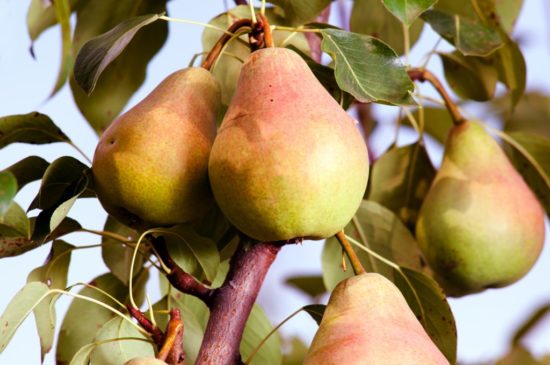
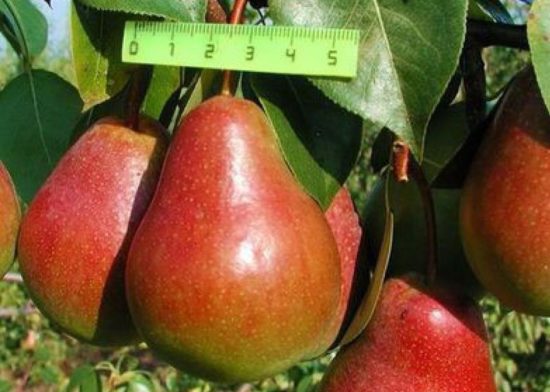
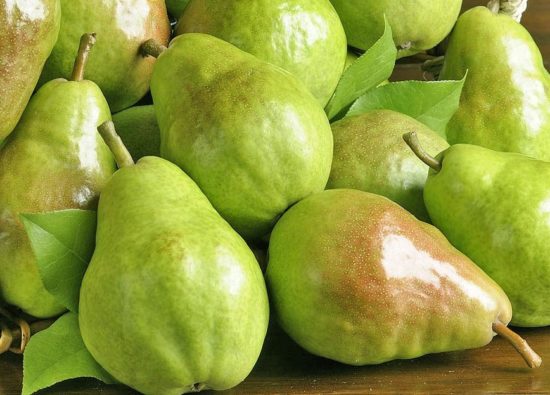
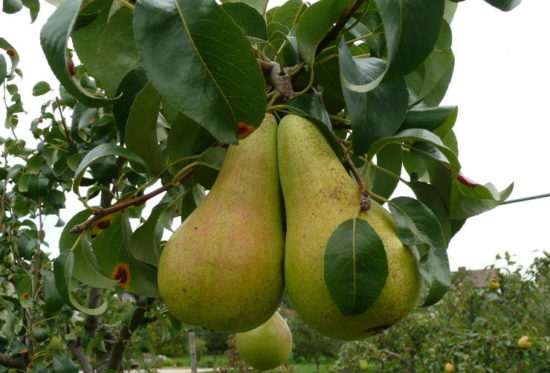
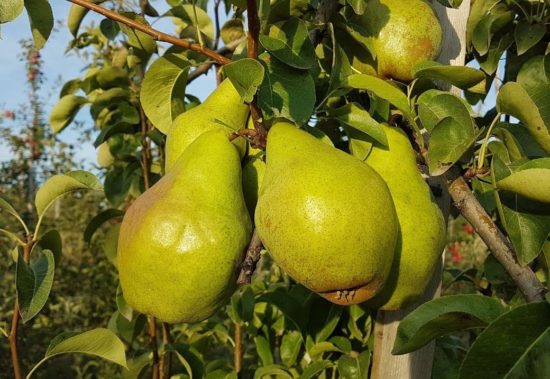
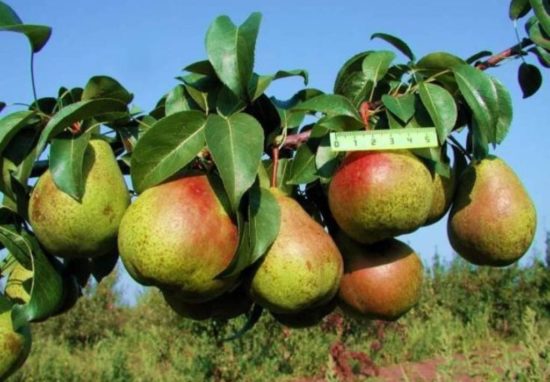
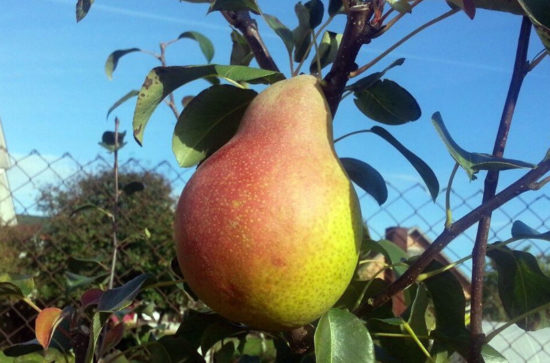

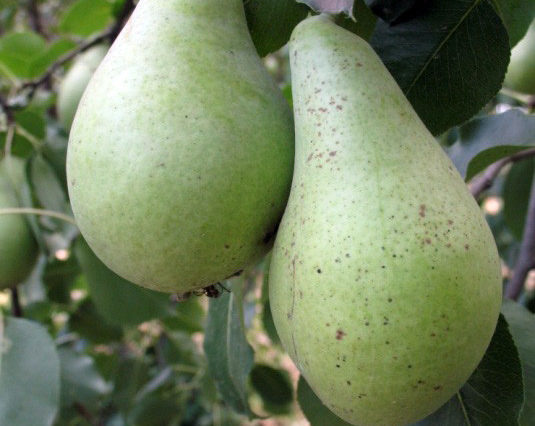
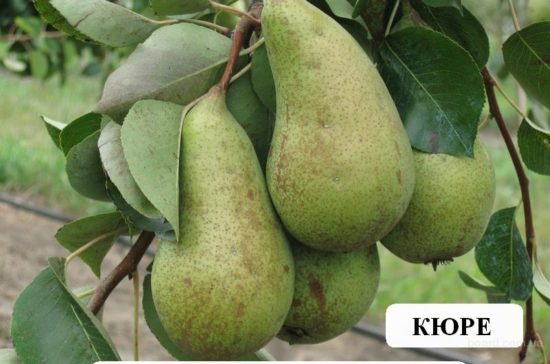
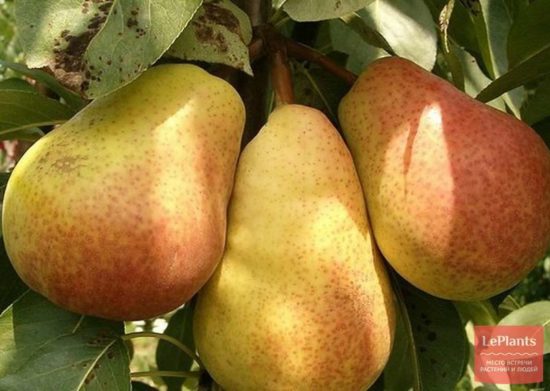
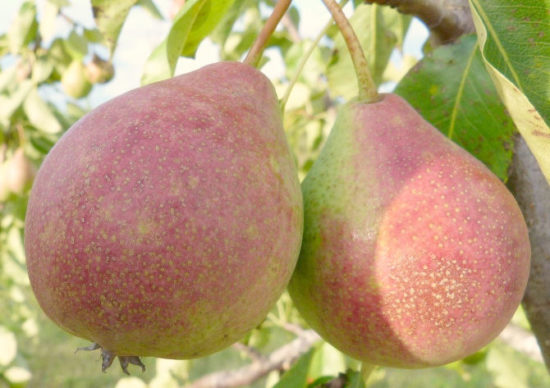
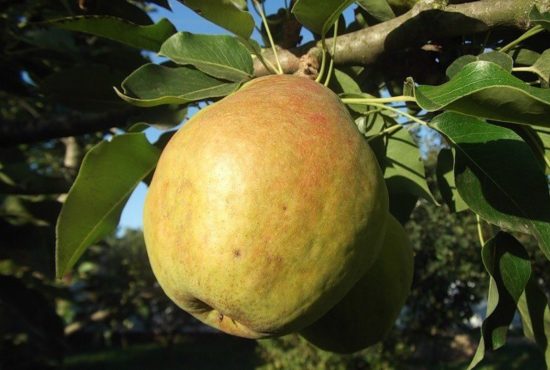

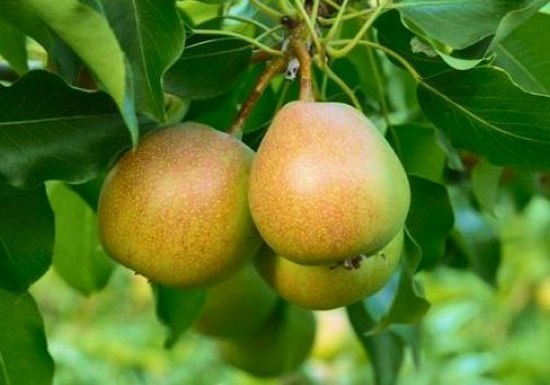
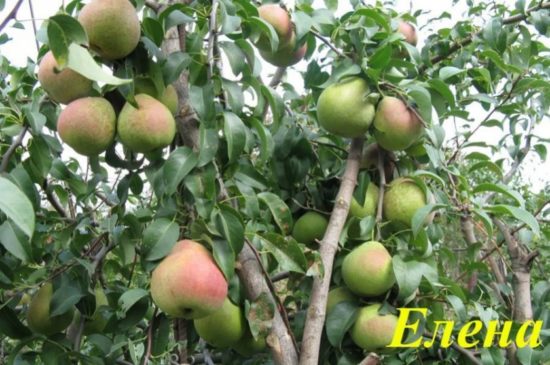

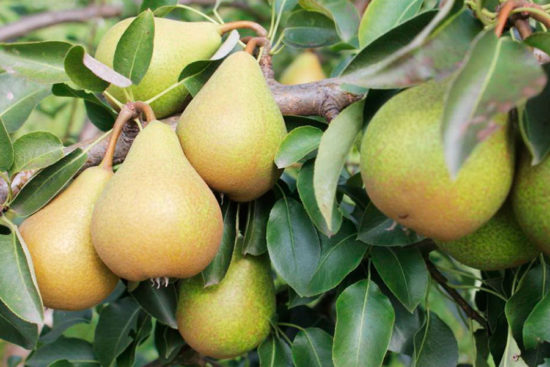

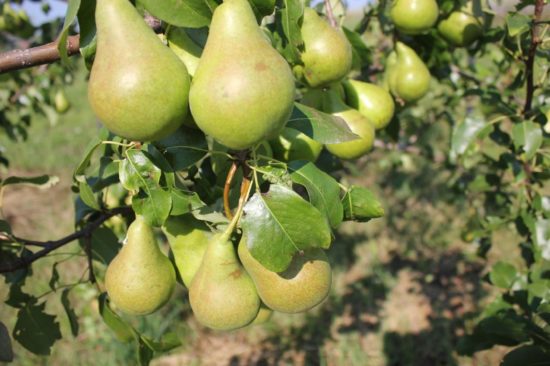
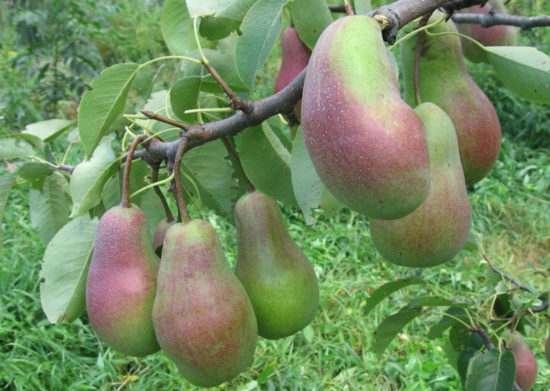

 CUCUMBERS NEVER GET SICK, I'VE BEEN USING ONLY THIS FOR 40 YEARS! I SHARE A SECRET WITH YOU, CUCUMBERS ARE LIKE THE PICTURE!
CUCUMBERS NEVER GET SICK, I'VE BEEN USING ONLY THIS FOR 40 YEARS! I SHARE A SECRET WITH YOU, CUCUMBERS ARE LIKE THE PICTURE! You can dig a bucket of potatoes from each bush. Do you think these are fairy tales? Watch the video
You can dig a bucket of potatoes from each bush. Do you think these are fairy tales? Watch the video
 How our fellow gardeners work in Korea. There is a lot to learn and just fun to watch.
How our fellow gardeners work in Korea. There is a lot to learn and just fun to watch. Eye trainer. The author claims that with daily viewing, vision is restored. They don't charge money for views.
Eye trainer. The author claims that with daily viewing, vision is restored. They don't charge money for views. A 3-ingredient cake recipe in 30 minutes is better than Napoleon. Simple and very tasty.
A 3-ingredient cake recipe in 30 minutes is better than Napoleon. Simple and very tasty. Therapeutic exercises for cervical osteochondrosis. A complete set of exercises.
Therapeutic exercises for cervical osteochondrosis. A complete set of exercises. Which indoor plants match your zodiac sign?
Which indoor plants match your zodiac sign? What about them? Excursion to German dachas.
What about them? Excursion to German dachas.